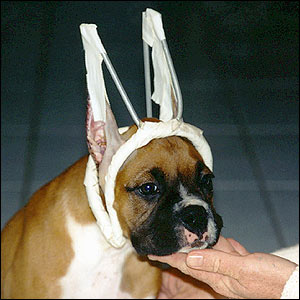Probably one of the most frequent reasons for visits to the vet is an ear infection. Often, the pet parent will first notice a strange odor or see the pet scratching or pawing at the ear.
The picture on the left shows the appearance of ear mites as I explained. It is very dark and grainy. Its important to clean the ears as good as possible before applying ear mite medication.
Below is a microscopic view of the ear mite.
As I said, dogs, typically have other ear issues. Normally, these are yeast or bacteria related. Dogs with floppy ears and long haired dogs with thick ear hair are most susceptible to infection. The reason for this is the warm, moist environment created. A very easy way to make the environment inhospitable to infection is by weekly cleaning with a vinegar:water mixture, making the environment more acidic, and for dogs with ear hair, plucking the hair.
To the left is an ear with a yeast infection. Notice the dry, flaky appearance. Yeast infection can easily spread to other parts of the skin such as the paws when the dog scratches. You can also find that you will see ear infections in pets with any allergy that affects the skin, including food allergies. Remember, the ear is just another part of the largest organ on the body....the skin. So a food allergy can cause big problems even in the ears.
To the right is an ear with a bacterial infection. Notice how moist the area is. This will come along with a very strong odor, redness and swelling. In this case, a vet would probably shave the surrounding fur, flush the ears with a nolvasan solution and apply a topical medication. Some veterinarians will sedate the pet if he/she feels that cleaning will be too painful for the pet. This is why its so important to do regular physical exams at home, so a problem like this does not occur.
Ear cropping proponents claim that cropping prevents ear infections, however, according to the Textbook of Small Animal Surgery, 3rd Ed, there is no medical advantage to the procedure at all. Ear cropping is the common name of the otoplasty procedure where the outer portion of the ear is removed. It is common in Great Danes, Boxers, Dobermans, Pitbulls, Boston Terriers, and a few other breeds.
Historically, it was done without anesthesia on dogs who were livestock guardian dogs, but most often for baiting and fighting dogs. Puppy mills still continue the practice without anesthesia as they do tail docking.
The idea that ear cropping prevents infection is because it allows air flow into the ears. However, if it were as helpful as believed, ear cropping would be done to dogs prone to infection such as those who spend lots of time in water. Labs and Golden Retrievers, both who typically love water and are hunting dogs, often come into the vet hospital with ear infections. Yet an ear cropping is never suggested.
The truth is this procedure is done because tradition has dictated it as has dog show conformation standards and because humans like the look of it in certain breeds. The doberman and pit bull look much more fierce with cropped ears, for instance.
Thankfully, this is changing. The AKC says that uncropped dogs will not be disqualified and people are starting to realize that if we are going to change the vicious reputation of "bully breeds" in America, we have to stop making them look the part. We have to be honest and acknowledge that ear infection prevention is not the real reason for putting the dog through the procedure.
So, its up to us to keep an eye on our pets and to look out for problems. This saves us money and ensures the comfort of our pets.
Simple, frequent exams, weekly ear cleaning, and plucking if necessary, can prevent so much trouble.
Proactive Pet Parenting....its what its all about.















































